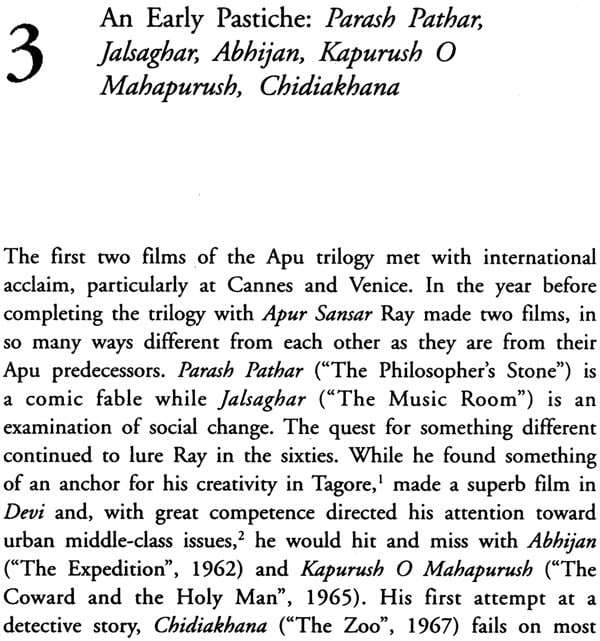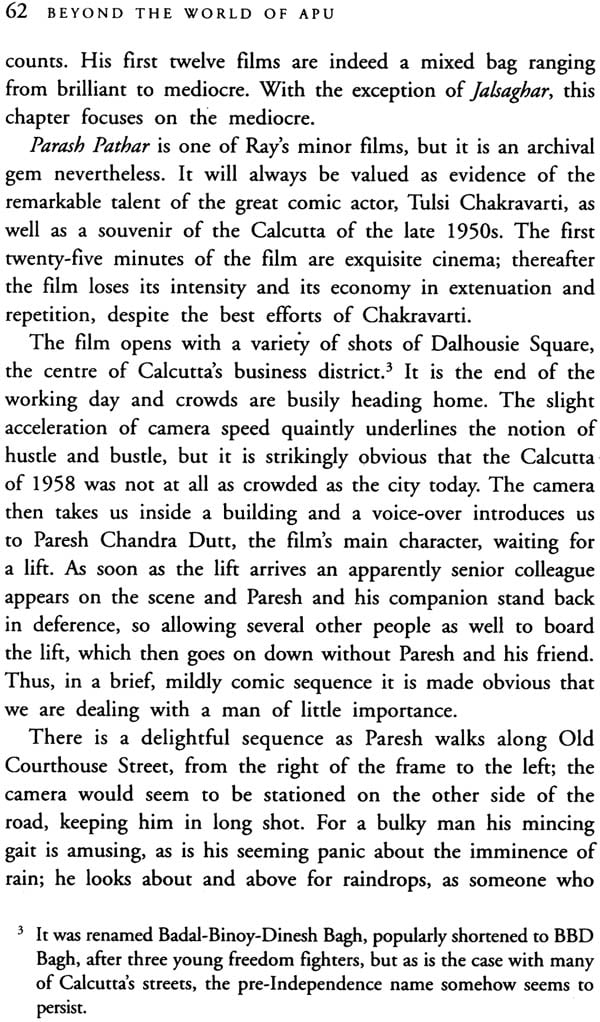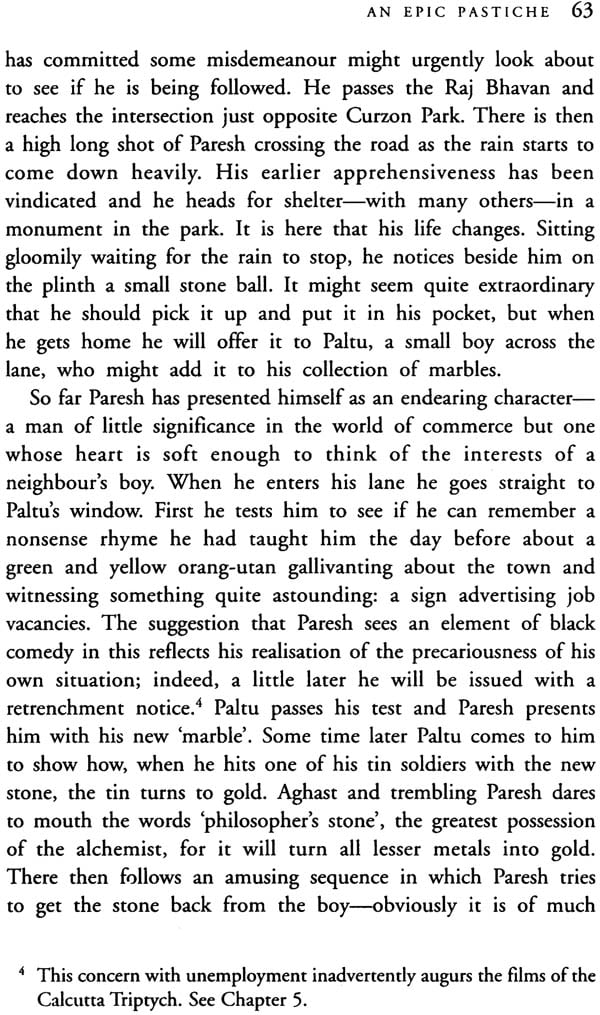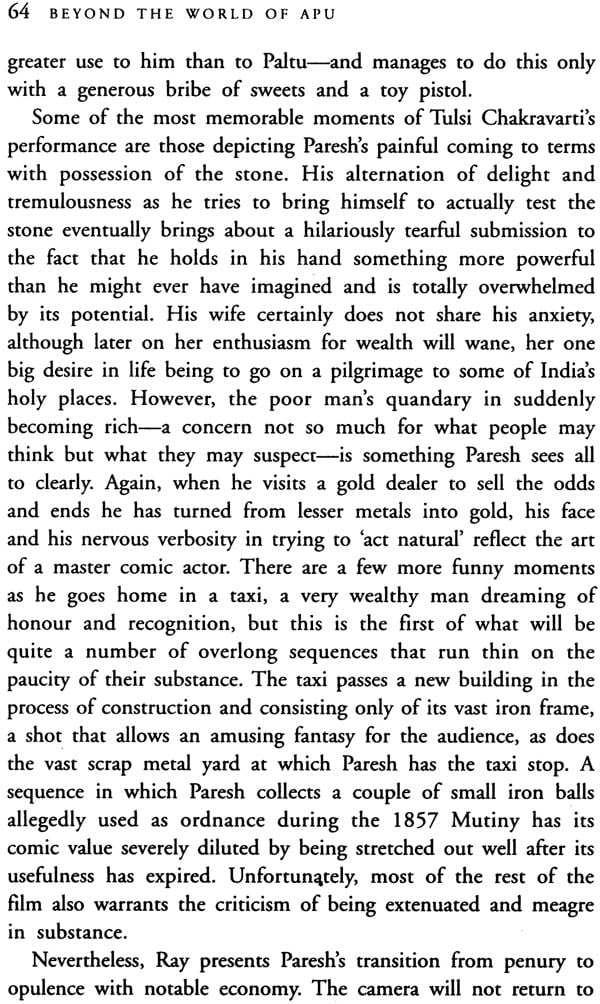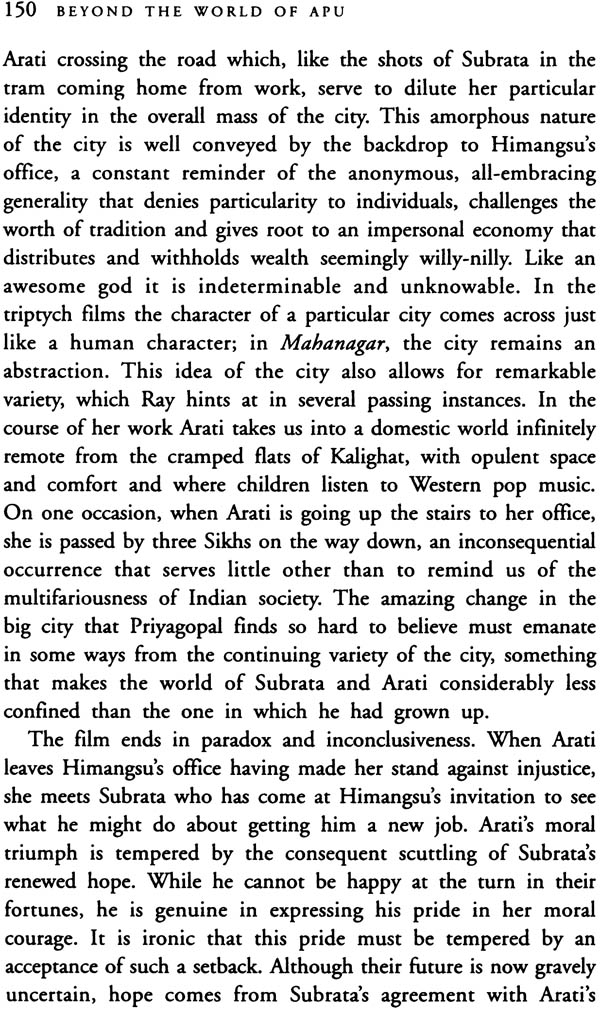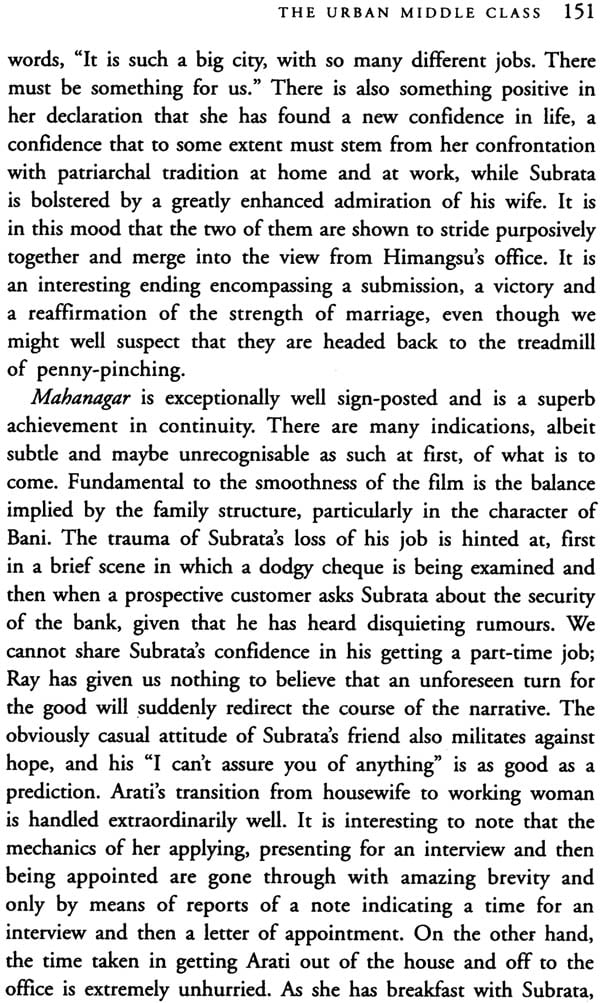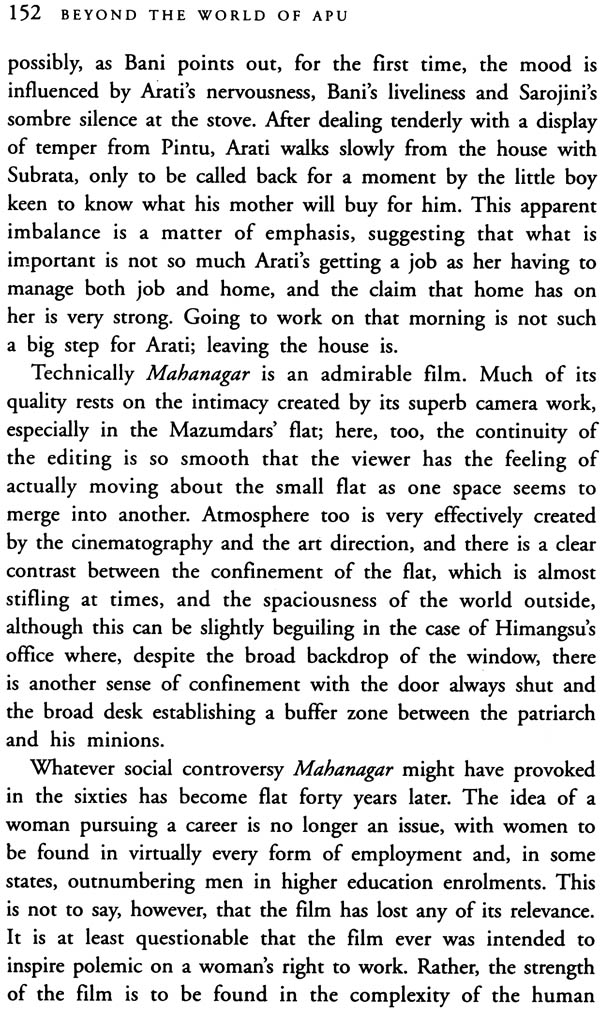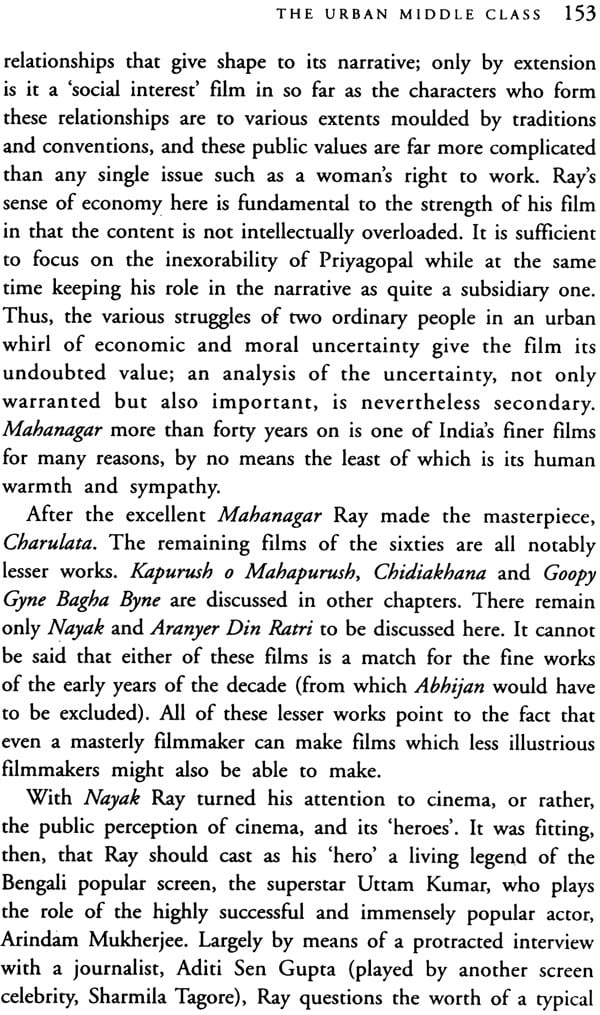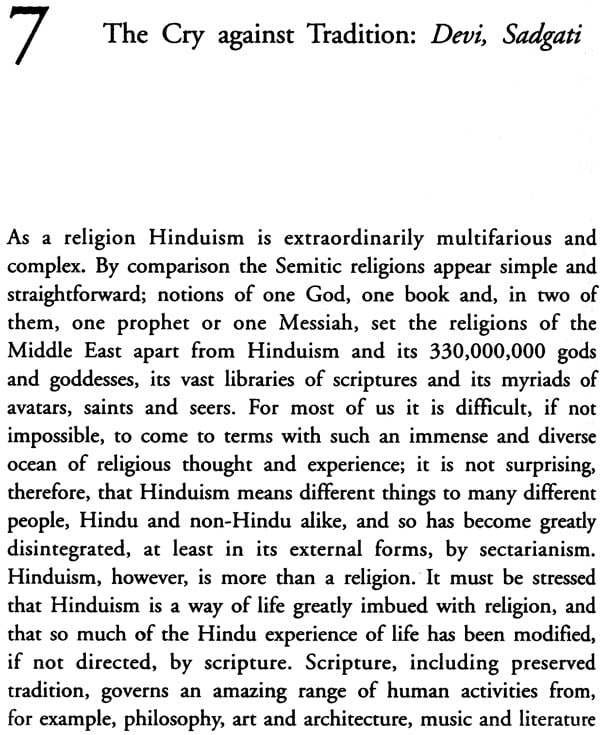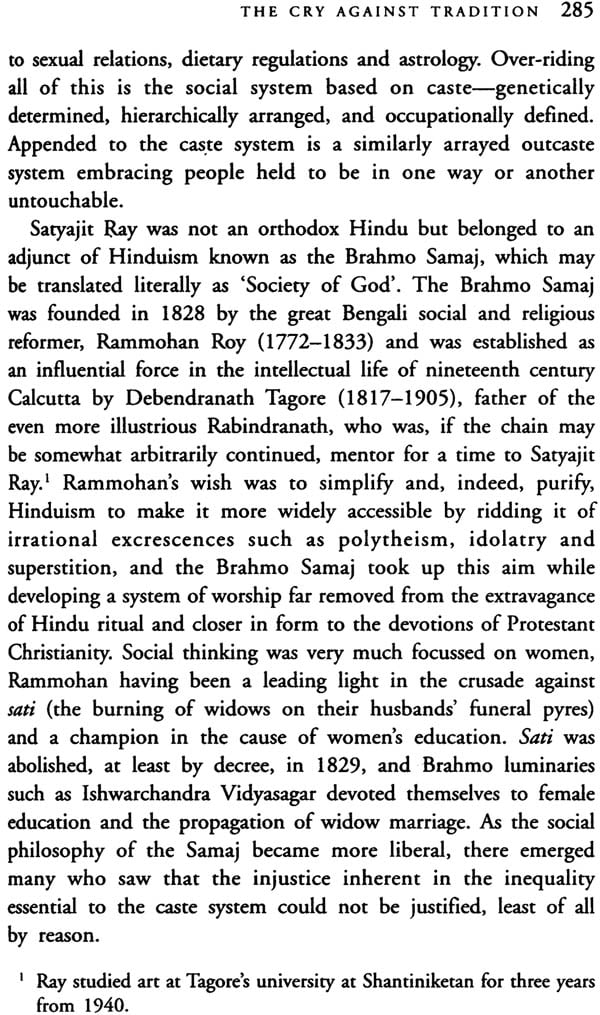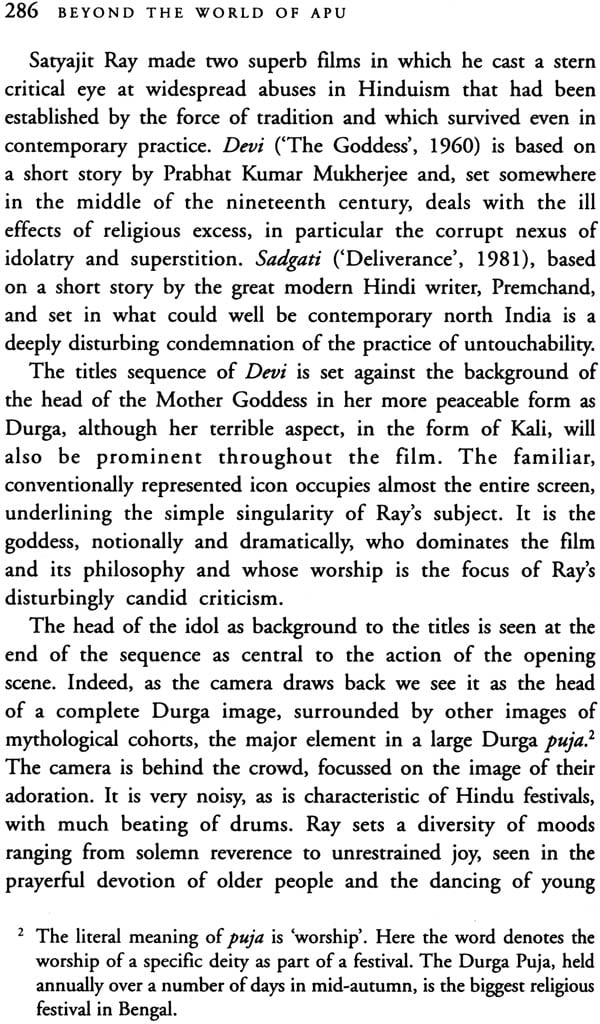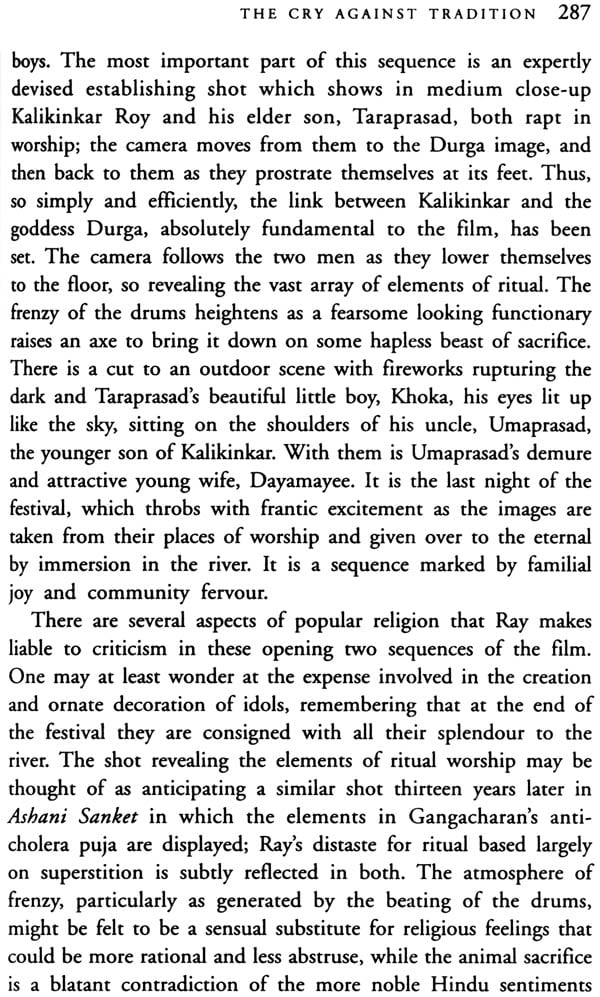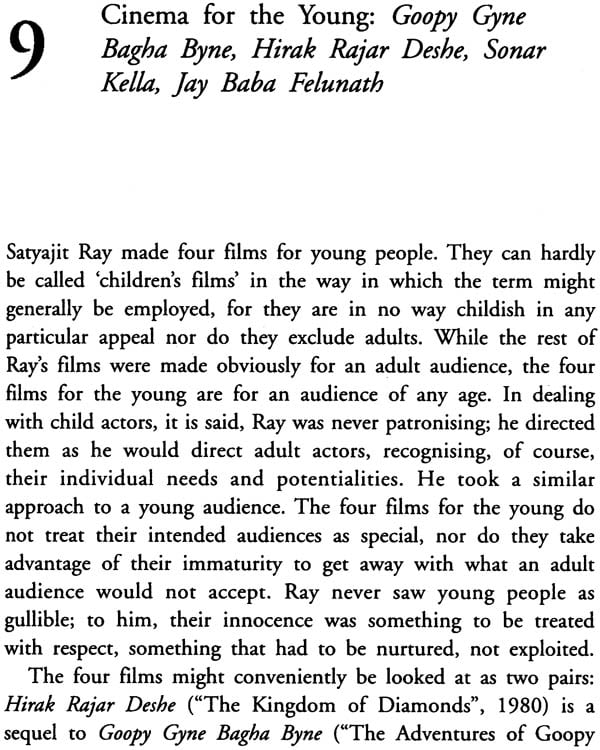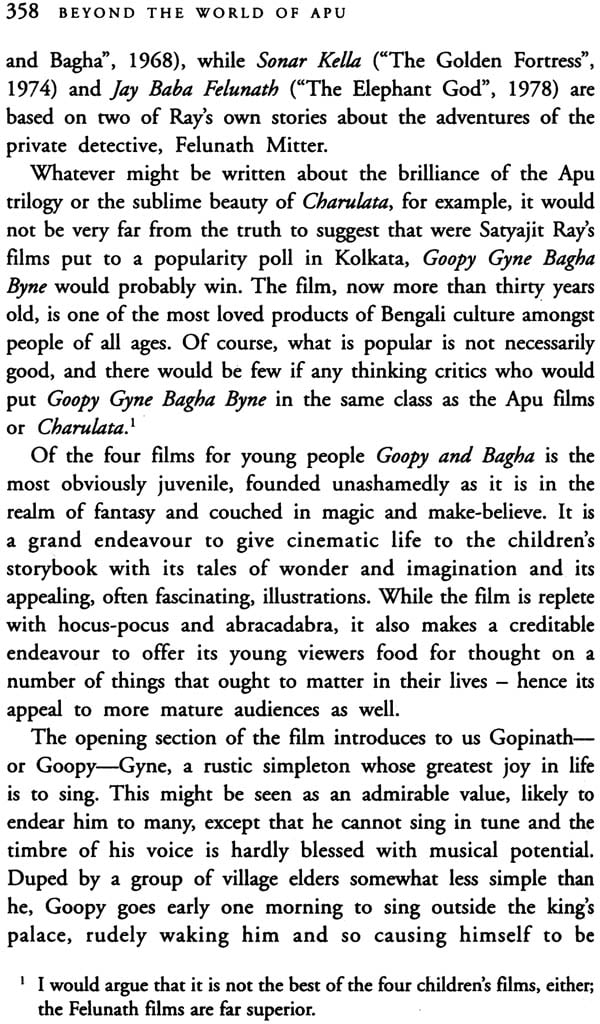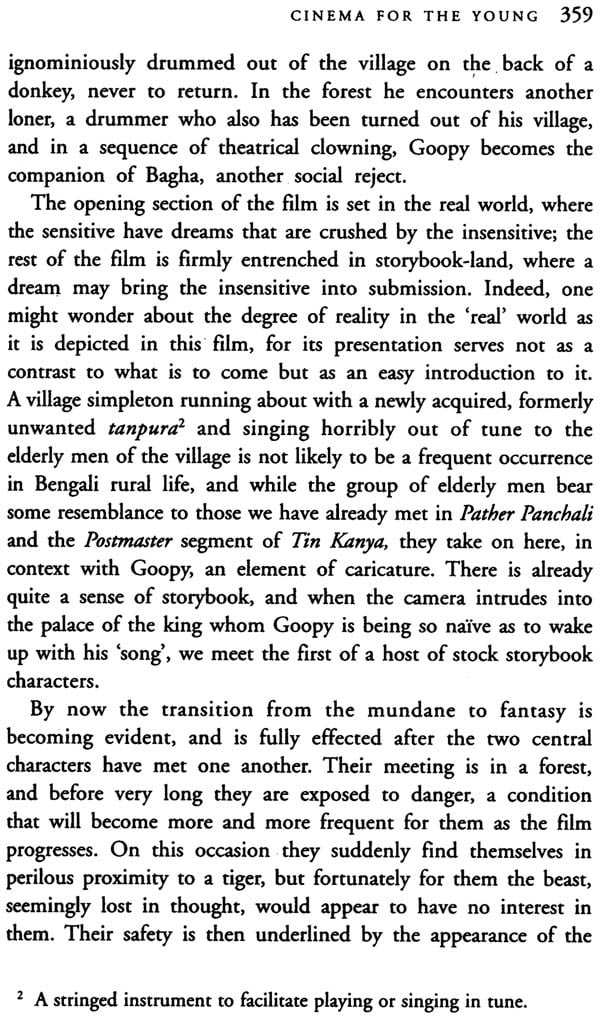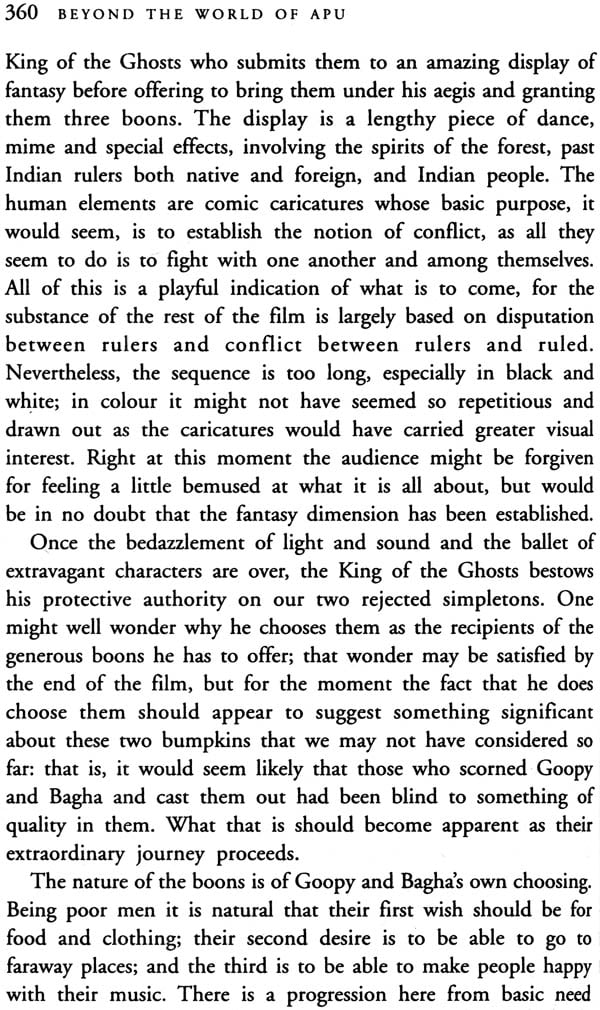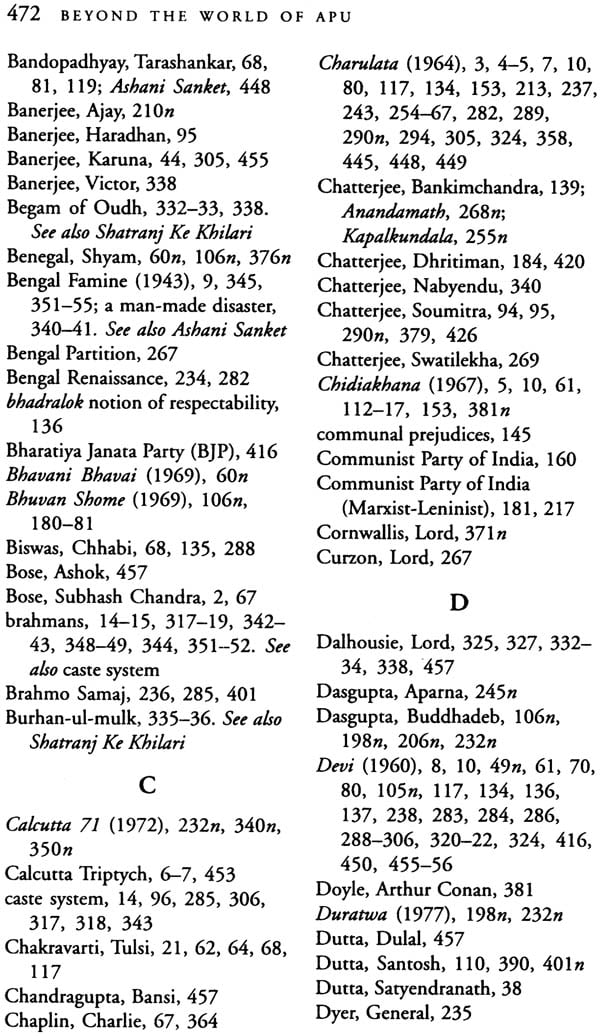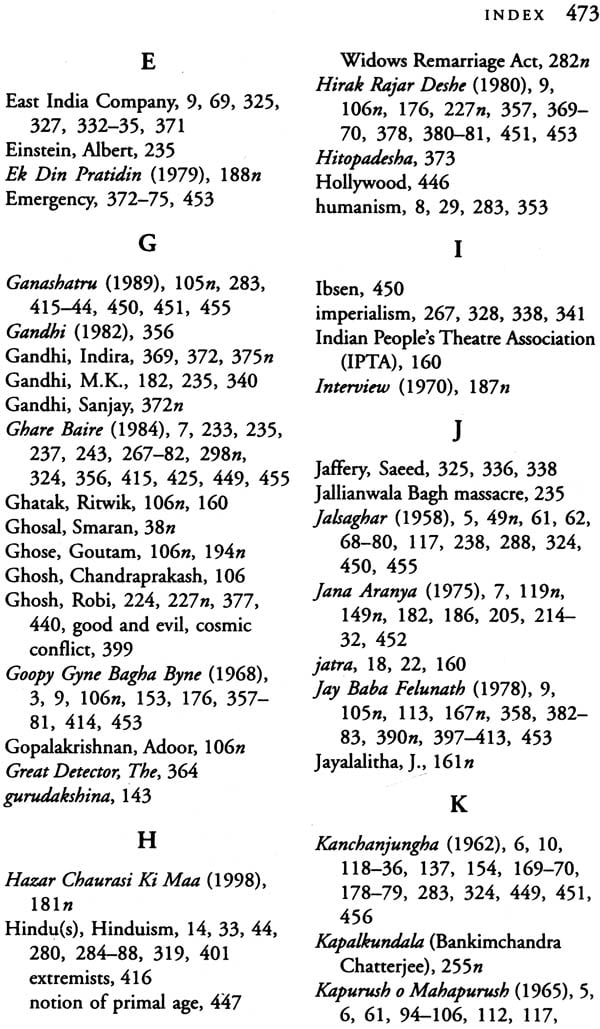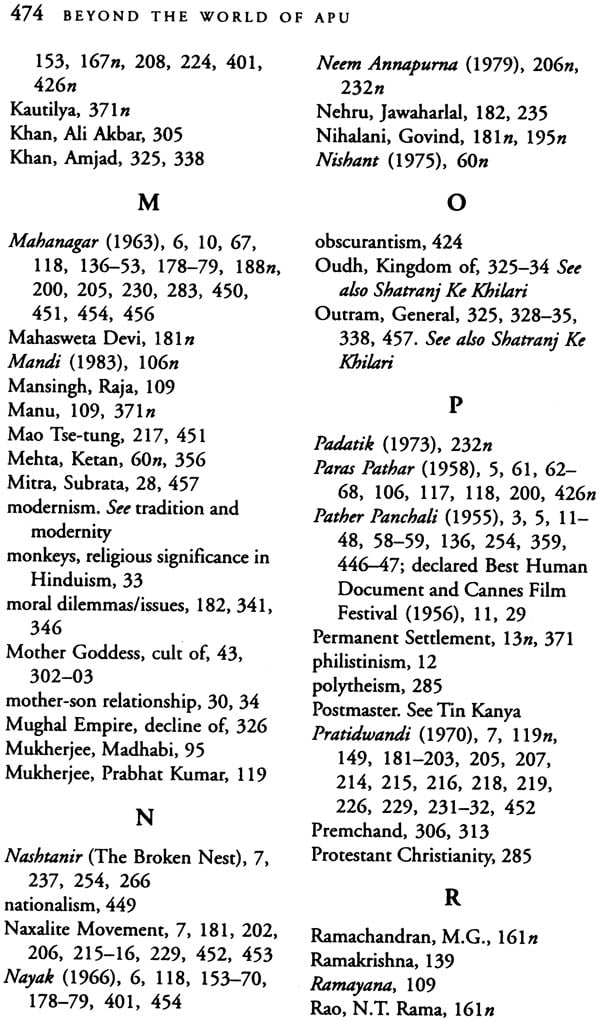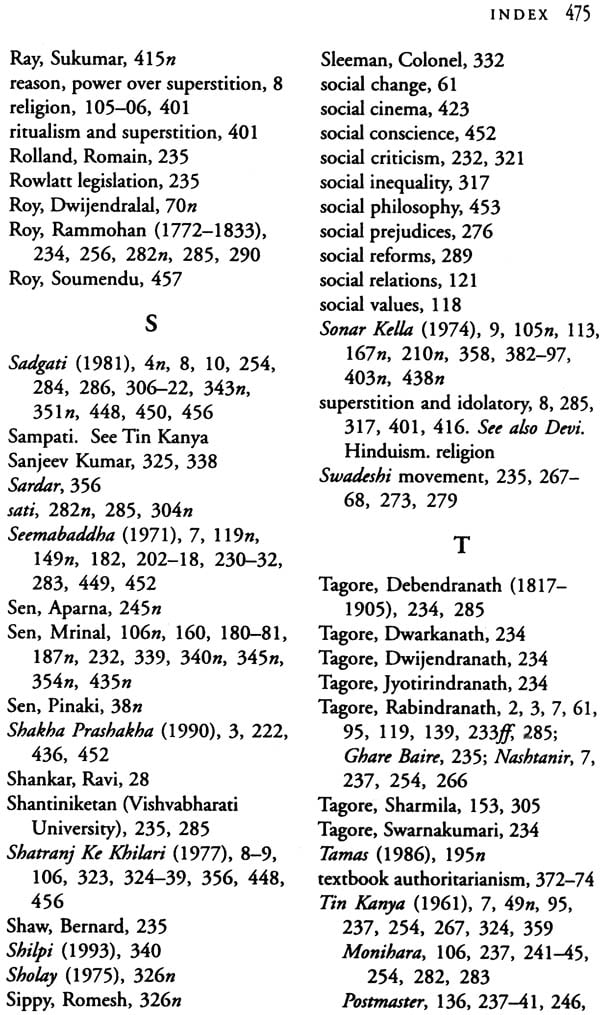
Beyond The World of Apu (The Films of Satyajit Ray)
Book Specification
| Item Code: | NAG536 |
| Author: | John W. Hood |
| Publisher: | Orient Longman Pvt. Ltd. |
| Language: | English |
| Edition: | 2008 |
| ISBN: | 9788125035107 |
| Pages: | 488 |
| Cover: | Paperback |
| Other Details | 8.5 inch X 5.5 inch |
| Weight | 480 gm |
Book Description
In this new work, John W. Hood makes a thoroughly informed, socio-historical critique of all twenty-nine feature films of Satyajit Ray. Structured along themes which the author has identified in Ray's movies, this reassessment analyses each film independently, on the basis of its individual merits and lapses, carefully avoiding the popular hagiography that is common to much of Ray criticism. Having taken us through the two ends of the spectrum of excellence and mediocrity that comprise Ray's work, Hood concludes his incisive study by affirming that "what makes Ray ascend into the realms of the great is his profound sense of humanity".
A highly accessible work on arguably the finest film-maker India has ever produced, this book will engage not only serious readers of cinematic texts but also be a valuable learning resource for students of film studies, all over the world.
About the Author
John W. Hood was born in Melbourne in 1944. He majored in Philosophy and Indian Studies at the University of Melbourne, where he also took his Ph.D. degree on Bengali vernacular historiography, specialising in the work of the late Professor Niharranjan Ray.
He is a recognised scholar of Indian art cinema, and has written books on the works of Mrinal Sen and Buddhadeb Dasgupta. His The Essential Mystery: Major Filmmakers of Indian Art Cinema is published by Orient Longman. He is a noted translator of Bengali Literature, having translated the fiction of Prafulla Roy and Buddhadev Guha and the poetry of Buddhadeb Dasgupta. He has also translated the classic History of the Bengali People by Niharranjan Ray.
John W. Hood divides his time between his homes in Melbourne and Kolkata.
Foreword
By the time I was ten I had read Bibhutibhushan's novel, Patber Panchali, twice and I was so struck by the story that the characters of the novel stayed long in my mind. Then, when I was just twelve, I saw Saryajit Ray's film based on the novel in a small town where my father was posted. Perhaps that was the first and the last time that I saw the characters of a novel projected so faithfully on celluloid - just the way I had imagined them when I read the book. That was the beginning of my journey through the films of Satyajit Ray. Not that I am equally enthusiastic about all of his work; indeed, I have strong reservations about some of his films. Nevertheless, I believe that it is mandatory for any prospective filmmaker to see Ray's films a number of times in order to learn about the interweaving of craft with creativity.
A long time later, when I was a college student, I met Ray at his Lake View Road apartment. I was most struck by his height, his bass voice, his British-like manners and, of course, his eyes. The impression was so powerful that I find it extremely difficult to disown his presence. Subsequently I had the chance to meet him on many occasions, such as in Venice in 1981, where I was showing one of my films in the competition; Satyajit Ray was one of the international jury, along with Andrei Tarkovsky and others. He liked my film very much and was free with his praise for it to the press and his many friends. He was always like that, ever generous with his encouragement for younger filmmakers whose work claimed his attention.
I am sure he did not create such a striking impression only with me, but also with everyone who met him, Indian or non- Indian. Among them were authors who wrote books on him and his work. I have not read them all, but I must say that whatever I have read I have not found to be always a notably objective criticism of his films, for Ray's charisma has so often guided the writer's pen. I understand that it is often very difficult to break free from this unseen influence and write a critical analysis that is truly objective.
Although John W Hood may deem it his misfortune never to have met Satyajit Ray, at least he was never shadowed by the great man's overwhelming personality. Thus it has been possible for him to be completely detached and write such objective interpretations. This work is quite original in that it discusses in considerable depth and detail all of Ray's films. It is a careful, critical analysis, well reasoned and without any attempt to fit the author's views to a pre-conceived, academically popular theory, something which, unfortunately, I have found in so many of the writings on Ray. It is very important to distinguish between positive, reasoned criticism and flattery. I have always believed it to be an injustice to the artist to rate his lesser works alongside his greater ones. In the creative process it is only natural that an artist's endeavours will not all bear the same quality of brilliance. It would be silly to try to equate The Taming of the Shrew with Hamlet and would be unjust to Shakespeare.
Of paramount importance in writing on any of the creative arts is the neutrality of the writer. I have seer. in India how personal acquaintance and petty antagonism have so often blurred an assessment of a film, a book or a work of art. Certainly John Hood's book has avoided such pitfalls. After I read the manuscript, it was clear to me that he has undoubtedly maintained his objectivity. This is to some degree because the author has kept a foot in two streams. For decades he has been closely involved in the study of Bengali culture, and this has been enriched by his own Western experience. To a great extent this corresponds with Ray's own life experience. Many of us saw Ray as a man who could have lived as comfortably in the nineteenth century as in the twentieth century, in India or in the West, and his films reflect his cosmopolitan experience.
Another important quality of this book is that the writer, while well-versed in the literature on which Ray based so many of his screenplays, has not been tempted-as so many critics have been-to make critical comparisons between a book and a film, all too often blaming the filmmaker for not being 'true' to the author. There were those critics who rejected even such great works as Ray's Apur Sansar and Charulata because the filmmaker asserted an independent mind in making the film instead of slavishly following the original text. One of the strengths of this book is that Or Hood has criticised Ray's films as cinema and not as literary adaptations.
I am sure this book will add an altogether new perspective in judging cinema in its truest sense and will remain a valuable textbook for anyone who wants to become seriously acquainted with the work of Satyajit Ray.
Introduction
Beyond the World of Apu is a personal reassessment. One of the reasons for writing this book was to address certain things I had said about Satyajit Ray's films in a book I started writing in 1995 Reading that chapter some ten years after it was first drafted I could see that several things needed to be corrected, a number of statements needed to be further elucidated and, most important, there were views expressed then with which I came later to disagree and wanted to revise. Changing one's mind may be, to some, an indication of a brittle intellect; I would prefer to think of it as an outcome of continuing thought. Cinema criticism is not a cut-and-dried science in which conclusions once reached become carved in stone. Constant familiarity with texts, both cinematic and literary, will frequently engender new insights, new perspectives and new assessments.
Thus, a substantiated acknowledgement of a change of mind, albeit a minimal one, is both a privilege and an obligation.
Satyajit Ray's films are almost as many as Shakespeare's plays."
As in Shakespeare's plays, so too in Ray's films there are a few masterpieces and a few inferior pieces, with the rest ranging from varying degrees of excellence to mediocrity; the simple indication of Ray's greatness is that his mediocre and lesser works are clearly outnumbered by those of obvious quality. Such a vast and varied output as his needs a much more extensive treatment than can be afforded by one chapter in a comprehensive book on Indian art cinema.
Satyajit Ray is one of a handful of established icons of the Bengalis, along with the maverick nationalist leader Subhas Chandra Bose and India's Renaissance Man, Rabindranath Tagore.! and one of the problems associated with iconic status is the difficulty of discerning between critical judgement and enthusiastic adoration. There is an even greater difficulty, which is having sound criticism accepted by the icon's devotees. Despite the unchallenged popular standing of Satyajit Ray, it is sad that there are very few Bengalis and still fewer Indians outside of Bengal, who have seen many of his films. The class of people to which this kind of discussion applies is relatively small, for a vast number of Indians, it must be said, have never seen a film at all, and many have seen cinema only on television.! Nevertheless, there must be many among the Bengali bhadralok, the educated middle class who consider themselves pillars of culture and the thinkers of India, who would know far more Bombay commercial films than films of Satyajit Ray, and yet be quick to defend him as one of their cultural giants. By the same token many bhadralok homes have a set of the complete works of Rabindranath Tagore in a place of prominence; this does not necessarily mean that they have read much of Tagore. There is, however, a small minority of intelligent, sensitive and well-read (in the sense that films are, indeed, 'read') aficionados of cinema whose knowledge of Ray, often profound and acutely perceptive, extends well beyond Pather Panchali and Goopy Gyne Bagha Byne. It is they who appreciate sound criticism and readily admit that not every Ray film is a masterpiece; while they are by no means iconoclasts, neither are they blind hero-worshippers.
Ray's paramount position in the art cinema of India is undeniable when one looks at the volume of his work and the awards and honours it has won him." The volume is somewhat formidable, and there must be relatively few people who have seen all his films-or who have seen some twenty-nine films of any filmmaker. Thus, it is easy to form a general opinion of acclaim based on, perhaps, a few of his films along with his well published international reputation, but whether or not that opinion is a respectable one is another matter. Furthermore, making judgements about Ray in regard to any of his contemporaries or successors-which is not an aim of this book- can only be done on the basis of a thorough appreciation of most if not all of the films of both parties. Merely to assert Ray's greatness, without comparison-which is an aim of this book- requires a careful substantiation based on a thorough appreciation of all of his films. Indeed, it is important for Satyajit Ray's own reputation for the critic to clearly demonstrate that his masterpieces are relatively few; it would do him no honour-or justice-to have Shakha Prashakha, put on the same level as Charulata or to have Agantuk rated alongside Aparajita. There is certainly value in arguing that Pather Panchali, Aparajita and Charulata are genuine masterpieces, but the value of rating films on a comparative scale, as is done, for example, with international cricket teams, should be regarded with considerable suspicion. It is often all too easy to declare one film better than another, as I have done on more than one occasion; what is more important is to see each film on its own particular merits, or lack of them.
This book is a critical appreciation of all the feature films" of Saryajit Ray. Each film is analysed in detail, with its strengths and, where appropriate, weaknesses being pointed out and argued. I have tried hard to avoid assertions of mere opinion, believing that what is important is the way in which the critic justifies his opinions rather than the opinions themselves. The book, then, aims to be no more than a critical examination of twenty-nine works of art, based simply on the texts themselves. It is not in any way biographical, nor does it make any claim to offer film history; it is simply a textual study, with minimal and incidental deference to the work of others in biography or film history.
I have therefore avoided a chronological approach, essential to biography and history, and have arranged my chapters according to certain themes that I see running through Ray's work. Doubtless, many would arrange the films differently, but the process is to some extent one of convenience, perhaps more cosmetic than organic; at least, that is so in this work, as I would not alter what I have said about any of the films were they in differently arranged chapters.
Contents
| Foreword | ix | |
| 1 | Introduction | 1 |
| 2 | The Apu Trilogy | |
| Patber Pancbali, Aparajita, Apur Sansar | 11 | |
| 3 | An Early Pastiche | |
| Parash Pathar, jalsaghar, Abhijan, Kapurush | ||
| O Mahapurush, Chidiakhana | 61 | |
| 4 | The Urban Middle Class | |
| Kanchanjungha, Mahanagar, Nayak, | ||
| Aranyer Din Ratri | 118 | |
| 5 | The Calcutta Triptych | |
| Pratidwandi, Seemabaddha, Jana Aranya | 180 | |
| 6 | The Tribute to Tagore | |
| Tin Kanya, Charulata, Ghare Baire | 233 | |
| 7 | The Cry Against Tradition | |
| Devi, Sadgati | 284 | |
| 8 | An Eye on the Past | |
| Shatranj Ke Khilari, Ashani Sanket | 323 | |
| 9 | Cinema for the Young | |
| Goopy Gyne Bagha Byne, Hirak Rajar Deshe | ||
| Sonar Kella, Jay Baba Felunath | 357 | |
| 10 | The Last Three Films | |
| Ganashatru, Shakha Prasbakba, Agantuk | 415 | |
| 11 | Some Final Remarks | 446 |
| Filmography | 458 | |
| Index | 471 |
